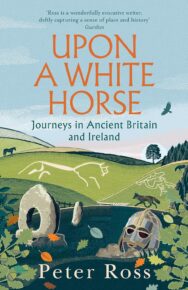‘Ross is always lucid, almost reverent, about the whole process of archaeological discovery.’
David Robinson enjoys Peter Ross’s latest travelogue in search of the UK and Ireland’s ancient past.
Upon A White Horse: Journeys in Ancient Britain and Ireland
By Peter Ross
Published by Headline
If you are writing about the lure of Britain’s deep past, you have to write about Stonehenge. If you write about Stonehenge, you have to write about the winter solstice. And if you have to write about the winter solstice at Stonehenge, you should start off something like this:
‘It was half past five in the morning, three days before Christmas, and King Arthur was on the bus …’
That’s how Peter Ross handles it anyway in his latest book, Upon A White Horse, taking the No 333 bus from Salisbury to watch the midwinter sunrise at England’s No 1 neolithic site. I can imagine him on it, tape recorder in hand, sitting next to the self-styled ‘king’ Arthur Uther Pendragon, his sword Excalibur slotted between them. Perhaps that intro is already forming in his head. And why not? It works.
King Arthur is a Druid, a biker with ‘Born to be Wild’ as the ringtone on his mobile (a typical Ross killer detail) and in his battle for free access to Stonehenge he was once defended in court by a certain Keir Starmer. In many ways, he is just too interesting (Arthur, that is, not Keir) – or, if you prefer, eccentric. Too much of him, or Stonehenge’s Archdruid Rollo Maughfling (‘he has an avuncular, plummy charm, but there’s something cosmic about him too’) could overbalance the story. And in any case, the building of Stonehenge had nothing to do with the Druids; by the time they came on the scene, a few centuries before the Romans arrived, it was already ancient and possibly in ruins.
Ross is too polite to take this up with King Arthur. In his text, though not in conversation, he points out that the Druidic link to Stonehenge was confabulated in the 1660s, and that the Ancient Order of Druids isn’t so ancient at all, as they were founded in 1781 at the King’s Arms pub in Soho. That’s not the point of the book: it’s not about splitting historical hairs so much as finding out why the ancient places of these islands cast such a strong spell. Behind that lie deeper, wider questions: is our interest part of a search for identity, simplicity and authenticity in an increasingly bland yet technologically frightening world? Is it a comfort blanket we need to cling to more strongly as our collective future darkens?
Some of the answers Ross finds are in surprisingly modern places, like Glasgow’s Sighthill Stone Circle (built in 1979 using the astronomical expertise of the father of Mogwai guitarist Stuart Braithwaite), Surrey’s Hascombe Stones Circle erected in the mid-1990s by members of a hippy commune, or the all-new neolithic-style barrow tombs like All Cannings in Wiltshire. Many such places are built out of a wish to memorialise loved ones in the most permanent way we can imagine – entirely understandable given the anonymous 15-minute farewells of so many crematorium services.
Sometimes the links to the past Ross uncovers are both visible and invisible. The Uffington White Horse, carved into the south Oxfordshire chalk hills a thousand years or before the Romans arrived, is indeed, as points out, an amazing bit of graphic design. More amazing still, though, is the fact that if the locals didn’t weed it and hammer in a new layer of chalk every year, within 25 years the hill on which the chalk horse is etched would be completely grassed over.
Just think, Ross writes, of everything that has happened since the horse was etched onto that hillside – the Roman invasion, the Norman Conquest, the two world wars – while in each generation local people ensured it was never put out to grass. There is a simple poetry in that fact, just as there is in the science of dating chalk layers by when they last saw sunlight, and his writing uncovers it. Again, an archaeologist might come up with a theory about the horse’s origins as a form of sun worship, but I prefer Ross’s pithier summary: ‘A prayer in chalk. Hallowed be thy mane.’
Personally, I have a bit of a blind spot about archaeology. I lack the imagination for it. (History is different: as soon as there’s a written record about how people thought, felt and behaved, I’m on board). I need a helping hand: a writer with a wide cultural frame of reference, who can write descriptively and accessibly, involving himself in a place either directly or through others. Ross fits the bill perfectly: at Uffington, for example, he joins in the parish’s annual weeding of the chalk horse and interviews XTC’s bassist about why the band used an image of the horse on their album English Settlement. On the site itself, he meets both dope-smoking teenagers and a retired brigadier working as a National Trust volunteer who keeps dementia at bay by memorising Anglo-Saxon poetry.
It’s the same weirdly wonderful story at Cerne Abbas, home of the club-wielding and notoriously well-endowed chalk giant (not prehistoric, apparently, but more likely Anglo-Saxon), where singer-songwriter Virginia Astley tells him about Gustav Holst meeting Thomas Hardy in Egdon Heath. On May Day, he’s there to see Wessex Morris Men dance round their monster mascot, as locals tear into donated barrels of local beer. As if that isn’t surreal enough, the local vicar then asks him if he’d like to meet Chesney Hawkes. ‘What do you make of it all?’ he asks him. ‘I live in LA,’ Hawkes replies. ‘You don’t get this on Ventura Boulevard.’
Yet do not, for a second, get the idea that this book is just a compendium of the strange, the unusual and the downright eccentric. Whether writing about Silbury Hill (the largest prehistoric mount in Europe, it would once have been entirely chalk white: according to novelist Adam Thorpe, ‘nothing as spectacular and lovely has been created since on our islands’), Avebury, Sutton Hoo, the bog-preserved bodies in Ireland’s National Museum, the Ness of Brodgar, or the massive Vindolanda camp on Hadrian’s Wall, or taking his son on a walk across the Antonine Wall, Ross is always lucid, almost reverent, about the whole process of archaeological discovery.
On Page 132 we find out why. One weekend when he was ten, his grandparents took him to a sand and gravel quarry near his Stirling home for his first dig. On the Friday night his grandfather had overheard a quarryman talking in the pub about how he’d accidentally unearthed a skull when his excavator bucket had smashed a stone slab. That slab, his grandparents – both amateur archaeologists – knew, was a Bronze Age burial cist that had been undisturbed for 4,000 years. They got out their trowels and started digging. Uncovering pieces of bone and of a beaker, they put them in a sealed plastic tub, and on the Monday morning reported the find to the council archaeologist. Imaginatively, they then asked their grandson to write it up for the archaeological journal Discovery and Excavation in Scotland.
There is a coda to the story that I won’t spoil by revealing. It is, however, worth pointing out that this anecdote does at least show that Ross has been in the archaeology and writing business for rather a long time. ‘Really,’ he writes, ‘I should have been an archaeologist rather than a writer…. Whenever I think about my childhood adventures in digging, I have a feeling of a path not taken. This book is an attempt to walk it a little.’
Upon A White Horse by Peter Ross is published by Headline, priced £22.














